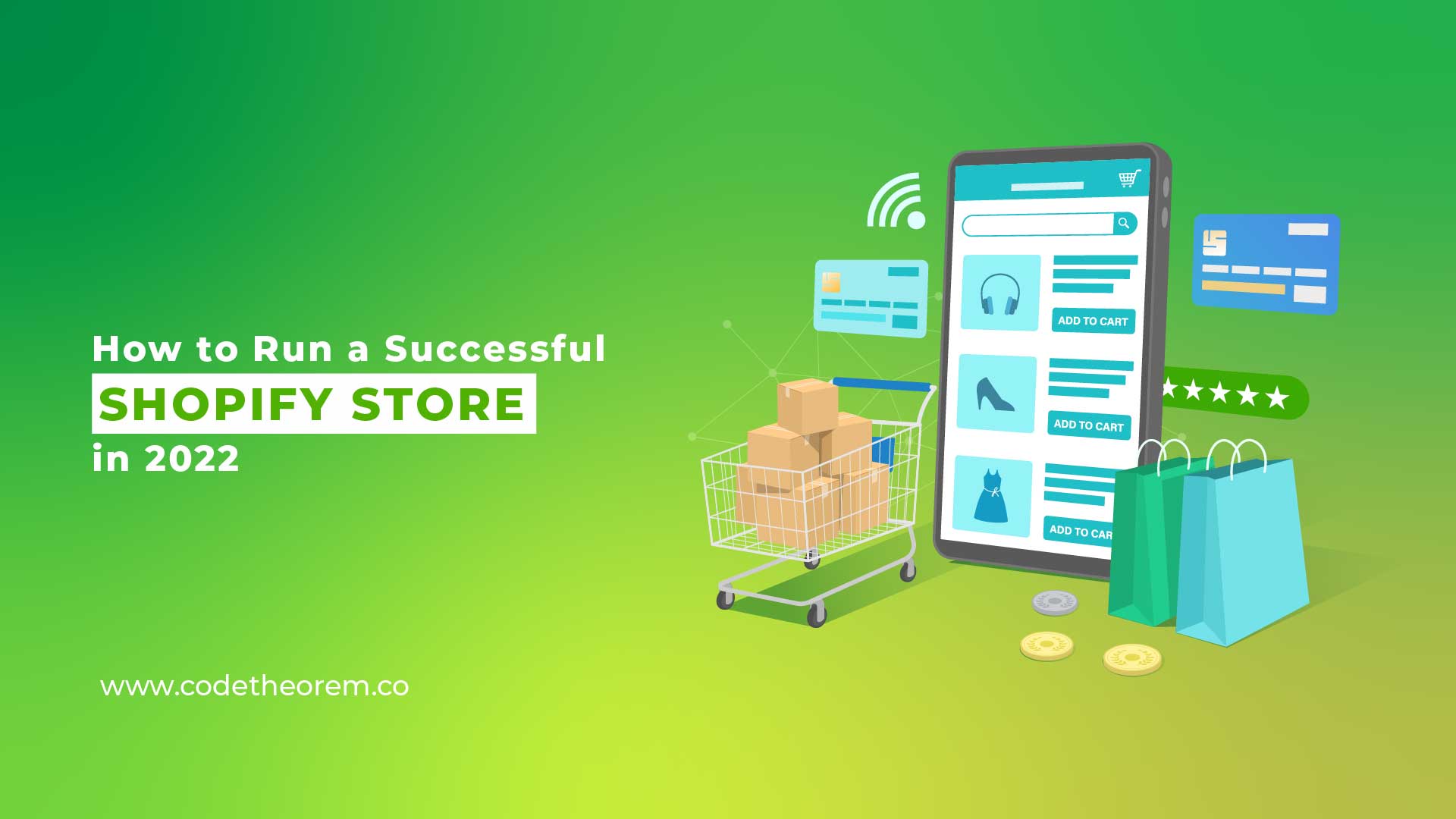Article content
Introduction
Having an ecommerce store in today’s time for a brick-and-mortar company has become a necessity. That is because the users’ habits have shifted towards digital. Moreover, customers today look for more personalized digital experiences. And the best and fastest way to start an ecommerce business is by setting up a Shopify store.
If you’re interested in starting your online store, too, this blog will walk you through everything there is to know about how to set up Shopify store. Furthermore, we will also discuss how to promote your Shopify website and run it successfully. But before we get to that, let’s understand what Shopify is and how it works.
Shopify Overview
Shopify is a subscription-based ecommerce website builder. This platform helps businesses to sell physical and digital products. You can either build a Shopify store or sell through an existing website. Moreover, you can also set up Shopify apps. This means you can conveniently operate your Shopify stores on your phone, anytime, from anywhere.
Furthermore, what’s best about Shopify stores is that they offer an instant buy button. The Shopify buy button enables you to sell through social media, guest blog posts, emails, and in person. You can place this buy button on non-Shopify websites or blogs to sell your products.
Shopify has a simple business structure. Therefore, it appeals to small and medium-sized businesses. But, it can also cater to larger enterprises with ease. It’s a one-stop destination for you to successfully develop, launch, organize and run your ecommerce store.
Steps to Make Successful Shopify Store
As complicated as it may seem at first, setting up Shopify stores is not that tough. Surprisingly, it is a straightforward process. If you follow the steps discussed ahead, it will hardly take 30 minutes (excluding the time that goes into business ideation and planning) for you to set up a Shopify store on your own. All you need is a solid plan and organizational skills. As a result, you will be able to create a successful Shopify store within minutes.
To break down and ease the process for you, this blog includes all the necessary steps to start a successful Shopify ecommerce business.
1. Build Your Plan
Before you start setting up your online store, you must think and work on your business and marketing plan. Therefore, you must try answering these questions:
1. What will be my marketing strategy?
2. How will my marketing strategy add to my online business’s growth?
3. Who will be my target audience?
4. How will I be accepting payments?
5. Do we have a shipping strategy?
6. Do we have a plan to sell internationally?
These questions will push you to do market and audience research. Consequently, you will come up with some of the most important answers. Later, these will become the foundation for building your branding and marketing strategy. Furthermore, it will also help you identify the market gaps and understand your audience’s needs and pain points. It doesn’t end here; you can also discover your competition and their pricing strategies. So, thinking through your entire marketing strategy before designing or developing your online store is imperative.
Moreover, you also need to decide from where you will source your products. Finding and partnering with an affordable yet reliable manufacturer or supplier is best. You can either check out online marketplaces like Alibaba or Indiamart or even go for local wholesale distributors. But, make sure you take your time to be sure about the supplier before making an investment.
2. Set Up Your Shopify Store
Once you’re sure about your business plan and marketing strategy, setting up Shopify stores is a piece of cake. But before diving into the website design part, you must first decide on your brand/store name and logo. Once done, you must buy a domain name. To do that, explore different Shopify plans and buy the one that’s best suitable for you.
1. Theme & Important Pages
After you’ve got the plan, you must either choose a pre-designed theme for your online store. You also have the option to design one yourself. This theme is the base of your Shopify online store design. Moreover, it plays a vital role in determining your conversion rate. Note that changing your store theme in the future is doable but still a hassle. Therefore, Shopify sellers should avoid it and choose a theme for the long run.
To select the right Shopify template, consider the following factors:
- Keep in mind your preferences and your audience: you can list the features you want on your online store. This will be your starting point when deciding the suitable themes for your store.
- If you want reliable designer and technical support, selecting themes from the Shopify app store is best.
- In today’s time, people are fond of fast and optimized digital experiences. Thus, you must pick one that meets their expectations. Moreover, fast-loading themes always convert better.
- Today, if your website is not optimized for mobile phones, it is losing many potential customers. Also, you will fail to retain the existing ones. Why? Because according to statistics, 74% of the users are to return to a website only if it’s mobile-friendly. So, it’s essential to have a mobile-responsive website or an application.
- Take reviews from your team. See what they have to say about the theme.
- The last thing that you need to consider is the Budget. Most Shopify themes in the Shopify theme store with numerous advanced features have to be paid for. But, if you’re only just starting out, limited functionality is sufficient for your store. So, you can go for free Shopify themes without any second thoughts. You can later upgrade your theme in the next 4 to 5 years as per your growth.
Next, you need to work on creating the critical pages of your Spotify store. For instance, the about us page, the home page, the contact us page, the return and shipping policies, and terms & conditions. While preparing content for these pages, make sure it’s easy to understand and relatable. Moreover, for the terms & condition page, keep in mind that transparency is the key.
2. Upload Your Products
All Shopify stores must have optimized product pages for each of their products. Then only will they have a high conversion rate? Therefore, while setting up the products’ pages, you must be careful with the images you upload. Moreover, it’s essential to be cautious with product descriptions, customer reviews, Shopify shipping information, and even your add-to-cart button. Note that all successful Shopify stores must have SEO-optimized titles and descriptions for all the listed products.
3. Stunning Checkout Page
Your checkout page plays a vital role in building confidence in the customers. Wondering how? Well, your checkout page showcases the type of security you provide. If you fail to convince your customers that their financial and personal details will be kept safe, they will not complete the purchase. Hence, you must have a clean, straightforward checkout flow. Moreover, keep the checkout page minimal. Ask for and provide necessary information only.
Tips for Making Your Shopify Store a Success
1. Improve Design
Once online orders start coming in, it’s essential to keep updating and improving your website. Keep providing customers with new features and itsy-bitsy, fresh changes in the design interface. Consequently, this will offer them a better user experience and keep them coming back to your site for more. Also, you can add a feedback survey to your website through the Shopify eCommerce platform. This will help you gain interesting feedback and insights from your customers. Based on that, you can improve your website.
2. High-Quality Images
While setting up a store on an eCommerce platform, images play a crucial role in conversions and purchases. They lure the customers towards the product. If you don’t provide the customers with high-quality product images, they will not be interested in buying the products. Low-quality, dull images won’t appeal to them to trust and purchase the product. Therefore, all the photos on your website must be high-quality. Then only can you attract customers and retain existing ones.
3. Collections of Product
Having limited product options under one product category will do no good. Thus, it’s better to have collections of each product. This will offer variety to the customers and help them find exactly what they’re looking for. For instance, you could offer collections of products based on seasonal weather forecasts. As a result, your customers get better access to the seasons’ items, which boosts your Shopify dropshipping store sales.
4. Customer Experience
Once your Shopify store is live, you must strive to provide a compelling customer experience. You can now cut out the fiction points if you have feedback from your team and customers. It could be design-related, speed or optimization, shipping, and quality reviews. You work on the areas of concern and improve your overall customer experience. Another essential aspect of a good customer experience is a 24/7 customer support team. Hence, you must ensure that your customers get that.
5. Flawless User Experience
Providing an excellent user experience is very crucial in today’s time. It determines whether the customers will stay on the page or not. From the website loading speed to high-quality pictures, the micro-interaction, and content structure, everything counts. According to statistics, there are fewer chances of 88% of users returning to a website after a bad user experience. Therefore, you must ensure that you take inspiration from some of the best website designs. The better the user experience, the more customers you attract and retain the existing ones.
6. Focus on Video Content
Videos attract the attention of customers like no other visual elements. So, having videos for all your products is a good practice. Through videos, customers can get a fair idea of what they want to buy before paying for it. You can also add tutorials for technical products, designer clothes, etc., to help customers understand how they can use them.
7. FAQs Page
New customers often have various doubts and queries. Therefore, you must provide them with a space where they can easily put up their questions. And FAQ pages are the best way to solve their issues and avoid incomplete purchases. For your customers’ convenience, you can also add the FAQ page link in the footer. This helps by answering all the common questions they have before they reach out to customer support.
8. Strong Call to Action
Call to Action buttons plays a huge role in motivating your customers to take action. Therefore, you must be careful with how and where you place them throughout your website. Furthermore, you must ensure that they are clear and straightforward. Usually, CTAs with value propositions, adverbs, and customized buttons have been known to do wonders for conversion rates. You must try running A/B tests for each one of them to understand which works the best.
9. Set Up Analytics
Another way to successfully run Shopify stores is by setting up Google analytics. You can then track which pages, sections, or CTAs on your website are performing better. Moreover, with Google Analytics, you can also track your website traffic and other essential online store metrics.
Promote Your Online Store
Promoting Shopify Stores, or any online store, for that matter, is not a challenging task today. You can do that through various mediums and methods today. One of the easiest and most effective ones is social media platforms. For starters, posting on social media is the best thing to do. Organically promote Shopify stores and add a Shopify button to your pages. Other frequently used options are:
- Paid Advertising
- Email Marketing
- Sponsoring Events (based on the scale of your Shopify Store)
- Influencer marketing
Conclusion
We’re optimistic that after reading this blog, you’re ready to create a successful Shopify store. So, if you follow the above-given steps, making your Shopify account and setting up a Shopify store wouldn’t take more than a few hours. Although this blog covers everything there is to know about selling on Shopify successfully; you can still reach out to Code Theorem if you have any doubts. We will gladly clear all your doubts and also help you set up a Shopify store within minutes.


















